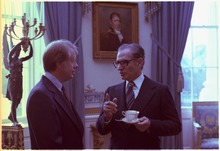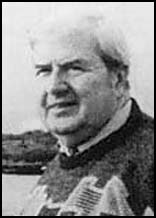Organization
Alexandre de Marenches initiated the pact with messages to the four other countries—and to newly independent Algeria, which declined to participate. [2]
The original charter was signed in 1976 by leaders and intelligence directors from the five countries: [3] [4] [5]
- France – Alexandre de Marenches, Director of the Service de Documentation Extérieure et de Contre-Espionnage (SDECE), the external intelligence agency
- Saudi Arabia – Kamal Adham, Director of Intelligence Al Mukhabarat Al A'amah
- Egypt – General Kamal Hassan Ali, Director of the Intelligence Mukhabarat
- Morocco – General Ahmed Dlimi, Director of Intelligence and commander of the Royal Moroccan Army
- Iran – General Nematollah Nassiri of SAVAK (Iranian Intelligence)
The charter begins: "Recent events in Angola and other parts of Africa have demonstrated the continent's role as a theatre for revolutionary wars prompted and conducted by the Soviet Union, which utilizes individuals or organizations sympathetic to, or controlled by, Marxist ideology." [3]
The group's purpose was therefore to oppose Soviet influence by supporting anti-Communists. [6] [7] The charter also says that the group intends to be "global in conception". [8] Its formation has been attributed to interlocking interests of the countries involved (which were already cooperating to some degree). Alongside ideological pursuit of global anti-Communism, these included the more concrete goals of military strategy and economic interests. (Examples include international mining operations and investments in apartheid South Africa's Transvaal Development Company.) [9] [10]
Infrastructure
The club sat on ninety-one acres of magnificent landscape, with Mount Kenya as a backdrop. There were mountain streams, rose gardens, waterfalls flowing into quiet pools... Peacocks, storks, ibexes, and exotic birds strolled about...”
Ronald Kessler,The Richest Man in the World: The Story of Adnan Khashoggi, 1986

The Safari Club takes its name (reportedly de Marenches' idea) [7] after the exclusive resort in Kenya where the group first met in 1976. The club was operated by Saudi arms dealer Adnan Khashoggi—also a friend of Adham's. [11]
The original charter establishes that an operations centre would be built by 1 September 1976 in Cairo. [8] The group made its headquarters there, and its organization included a secretariat, a planning wing, and an operations wing. Meetings were also held in Saudi Arabia and in Egypt. The group made large purchases of real estate and secure communications equipment. [2]
The creation of the Safari Club coincided with the consolidation of the Bank of Credit and Commerce International (BCCI). The BCCI served to launder money, particularly for Saudi Arabia and the United States—whose CIA director in 1976, George H. W. Bush, had a personal account. "The Safari Club needed a network of banks to finance its intelligence operations. With the official blessing of George Bush as the head of the CIA, Adham transformed a small Pakistani merchant bank, the Bank of Credit and Commerce International (BCCI), into a worldwide money-laundering machine, buying banks around the world in order to create the biggest clandestine money network in history." [12]
BCCI also served as an intelligence gathering mechanism by virtue of its extensive contacts with underground organizations worldwide. "They contrived, with Bush and other intelligence-service heads, a plan that seemed too good to be true. The bank would solicit the business of every major terrorist, rebel, and underground organization in the world. The invaluable intelligence thus gained would be discreetly distributed to 'friends' of the BCCI." [13]
United States involvement
The United States was not a formal member of the group, but was involved to some degree, particularly through its Central Intelligence Agency. Henry Kissinger is credited with the American strategy of supporting the Safari Club implicitly — allowing it to fulfill American objectives by proxy without risking direct responsibility. [14] This function became particularly important after the U.S. Congress passed the War Powers Resolution in 1973 and the Clark Amendment in 1976, reacting against covert military actions orchestrated within the government's Executive branch. [15]
An important factor in the nature of U.S. involvement concerned changing domestic perceptions of the CIA and government secrecy. The Rockefeller Commission and the Church Committee had recently launched investigations that revealed decades of illegal operations by the CIA and the FBI. The Watergate scandal directed media attention at these secret operations served as a proximate cause for these ongoing investigations. Jimmy Carter discussed public concerns over secrecy in his campaign, and when he took office in January 1977 he attempted to reduce the scope of covert CIA operations. [16] In a 2002 speech at Georgetown University, Prince Turki of the Saudi Arabian intelligence service described the situation like so:

In 1976, after the Watergate matters took place here, your intelligence community was literally tied up by Congress. It could not do anything. It could not send spies, it could not write reports, and it could not pay money. In order to compensate for that, a group of countries got together in the hope of fighting Communism and established what was called the Safari Club. The Safari Club included France, Egypt, Saudi Arabia, Morocco and Iran. The principal aim of this club was that we would share information with each other and help each other in countering Soviet influence worldwide, and especially in Africa. [17]
As the Safari Club was beginning operations, former CIA Director Richard Helms and agent Theodore "Ted" Shackley were under scrutiny from Congress and feared that new covert operations could be quickly exposed. [18] Peter Dale Scott has classified the Safari Club as part of the "second CIA" — an extension of the organization's reach maintained by an autonomous group of key agents. Thus even as Carter's new CIA director Stansfield Turner attempted to limit the scope of the agency's operations, Shackley, his deputy Thomas Clines, and agent Edwin P. Wilson secretly maintained their connections with the Safari Club and the BCCI. [16] [19]

















